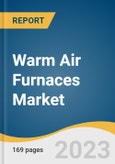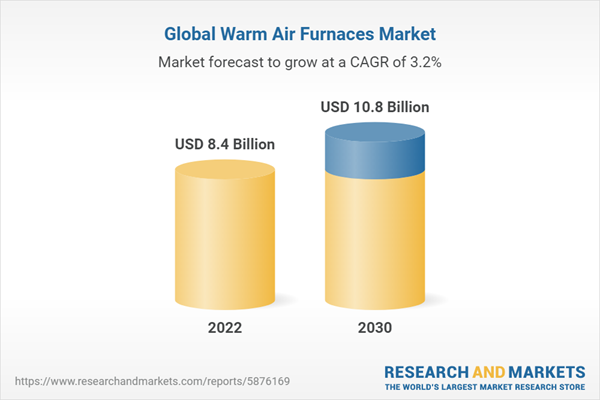The global warm air furnaces market size is expected to reach USD 10.8 billion by 2030, growing at a CAGR of 3.2% from 2023 to 2030. Increasing construction spending, as well as growing demand for highly energy-efficient heating solutions, are expected to drive demand for warm air furnaces across the globe. Furthermore, favorable government measures such as incentives for the installation of energy-efficient warm air furnaces are expected to benefit the market.
The U. S. construction activity increased by over 6% yearly in 2021 and 2022 after a 1.9% drop in 2020. The demand for single-family homes is the main factor driving the rapid residential construction. The strong demand for home remodeling and upgrading is still present because of increased discretionary household spending. A large portion of this growth will come from a significant rise in spending on residential building construction. The demand for warm air furnaces in the residential application segment is expected to be driven by the expanding residential sector in the U. S.
Furnaces use heat to circulate hot air using ducts throughout residential spaces due to the presence of drastic temperature changes. Furthermore, in the year 2022, the U. S. Energy Information Administration (EIA) reported that 538,000 of the 911,000 new single-family homes had forced-air furnaces installed.
The minimum Annual Fuel Utilization Efficiency (AFUE) standard governs furnace efficiency in the U. S. Seasonal efficiency is estimated using AFUE, which averages peak and part-load conditions. In addition to estimating the amount of electricity required by the air handler, inducer fan, and controls, AFUE accounts for start-up, cool-down, and other operating losses that happen under actual operating conditions. The higher the AFUE, the furnace or boiler is more efficient. These aforementioned factors are expected to drive the demand for warm air furnaces in the coming years.
Commercial warm-air furnaces must have a capacity of at least 225,000 Btu/hr. They are intended to supply hot air via a duct system. In practice, commercial furnaces are the gas or propane heating parts of bundled roof-top units that are utilized in small to medium-sized business buildings. As condensing technology allows for energy savings from warm air furnaces, condensing furnaces extract additional heat by condensing the water vapor in the gases and achieve 90% or greater efficiency levels. These aforementioned factors are projected to increase the warm-air furnace demand in the forecasted years.
The U. S. construction activity increased by over 6% yearly in 2021 and 2022 after a 1.9% drop in 2020. The demand for single-family homes is the main factor driving the rapid residential construction. The strong demand for home remodeling and upgrading is still present because of increased discretionary household spending. A large portion of this growth will come from a significant rise in spending on residential building construction. The demand for warm air furnaces in the residential application segment is expected to be driven by the expanding residential sector in the U. S.
Furnaces use heat to circulate hot air using ducts throughout residential spaces due to the presence of drastic temperature changes. Furthermore, in the year 2022, the U. S. Energy Information Administration (EIA) reported that 538,000 of the 911,000 new single-family homes had forced-air furnaces installed.
The minimum Annual Fuel Utilization Efficiency (AFUE) standard governs furnace efficiency in the U. S. Seasonal efficiency is estimated using AFUE, which averages peak and part-load conditions. In addition to estimating the amount of electricity required by the air handler, inducer fan, and controls, AFUE accounts for start-up, cool-down, and other operating losses that happen under actual operating conditions. The higher the AFUE, the furnace or boiler is more efficient. These aforementioned factors are expected to drive the demand for warm air furnaces in the coming years.
Commercial warm-air furnaces must have a capacity of at least 225,000 Btu/hr. They are intended to supply hot air via a duct system. In practice, commercial furnaces are the gas or propane heating parts of bundled roof-top units that are utilized in small to medium-sized business buildings. As condensing technology allows for energy savings from warm air furnaces, condensing furnaces extract additional heat by condensing the water vapor in the gases and achieve 90% or greater efficiency levels. These aforementioned factors are projected to increase the warm-air furnace demand in the forecasted years.
Warm Air Furnace Market Report Highlights
- The gas-warm air furnaces segment led the market and accounted for a 94.4% share of the global revenue in 2022. Gas-warm air furnaces are cost-effective and versatile. Moreover, when natural gas burns, it causes little impact on the environment while reliably keeping the area warm. These aforementioned factors are anticipated to drive the demand for gas-warm air furnaces in the coming years
- The oil-warm air furnaces segment accounted for a 5.6% share of the global market in 2022. Oil-warm air furnaces are a popular alternative in areas of the country where natural gas is scarce. These provide a possibility to heat the area with renewable fuels. Several companies are now offering heating oil that has been combined with biodiesel, allowing their consumers to minimize their reliance on foreign oil while utilizing a domestic energy source. Moreover, biodiesel mixes emit fewer pollutants than pure heating oil
- The commercial segment led the market and accounted for a 40.1% share of the global revenue in 2022. For commercial properties such as offices, factories, and warehouses, warm air furnaces are used to heat the space quickly and cost-effectively. Further, the U. S. government is working on various efforts to upgrade its community infrastructure
- For instance, the U. S. Department of Transportation announced a USD 905.3 million investment in infrastructure development projects around the country in June 2021. The projects are carried out through the Infrastructure for Rebuilding America (INFRA) discretionary funding program. Twenty projects in twenty states are anticipated to be funded to rebuild bridges, ports, highways, and railroads. As a result, increased commercial building will likely boost the demand for warm air furnaces in the projected period
- The residential application segment is expected to witness a CAGR of 3.5% over the forecast period. The Consortium for Energy Efficiency (CEE) reports that 50% of American houses utilize natural gas furnaces as their major source of space heating, making furnaces the most common type of residential heating system in the country. Thus, increasing the use of warm air furnaces for residential applications is expected to propel the demand in the coming years
Table of Contents
Chapter 1. Methodology and Scope
Chapter 2. Executive Summary
Chapter 3. Market Variables, Trends & Scope
Chapter 4. Warm Air Furnaces Market: Type Estimates & Trend Analysis
Chapter 5. Warm Air Furnaces Market: Application Estimates & Trend Analysis
Chapter 6. Warm Air Furnaces Market: Regional Estimates & Trend Analysis
Chapter 7. Competitive Analysis
Chapter 8. Company Profiles
List of Tables
List of Figures
Companies Mentioned
- Carrier Corporation
- Mitsubishi Electric Corporation
- Emerson Electric Co.
- Ingersoll-Rand Plc
- Daikin Industries, Ltd.
- Rheem Manufacturing
- Lennox International
- Johnson Controls, Inc.
- Robert Bosch GmbH
- Viessmann Group
- Goodman Manufacturing
- Fujitsu
Methodology

LOADING...
Table Information
| Report Attribute | Details |
|---|---|
| No. of Pages | 169 |
| Published | August 2023 |
| Forecast Period | 2022 - 2030 |
| Estimated Market Value ( USD | $ 8.4 Billion |
| Forecasted Market Value ( USD | $ 10.8 Billion |
| Compound Annual Growth Rate | 3.2% |
| Regions Covered | Global |
| No. of Companies Mentioned | 12 |









